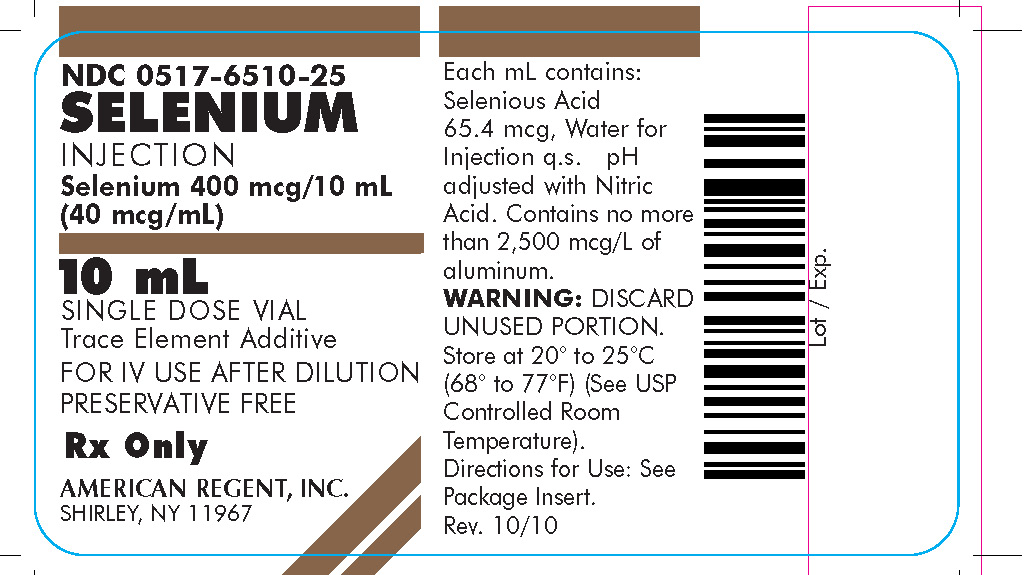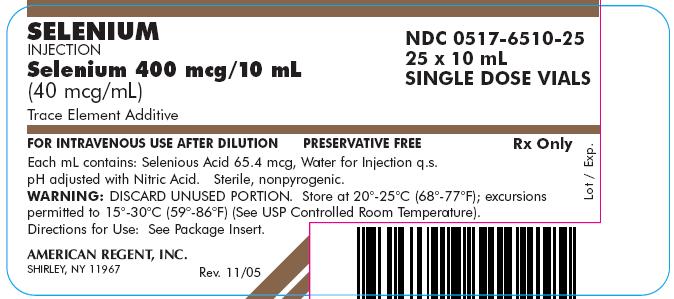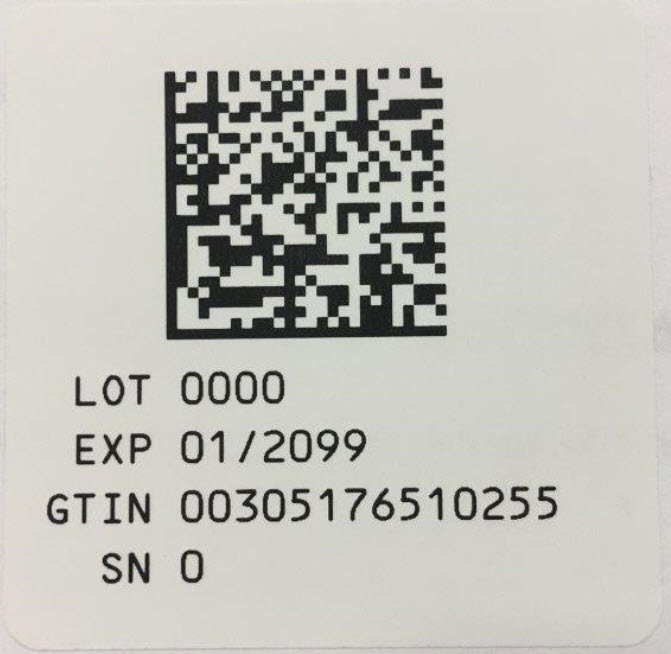SELENIUM injection, solution
Selenium by
Drug Labeling and Warnings
Selenium by is a Prescription medication manufactured, distributed, or labeled by American Regent, Inc., Luitpold Pharmaceuticals, Inc.. Drug facts, warnings, and ingredients follow.
Drug Details [pdf]
- SPL UNCLASSIFIED SECTION
- DESCRIPTION
-
CLINICAL PHARMACOLOGY
Selenium is part of glutathione peroxidase which protects cell components from oxidative damage due to peroxides produced in cellular metabolism.
Prolonged TPN support in humans has resulted in selenium deficiency symptoms which include muscle pain and tenderness. The symptoms have been reported to respond to supplementation of TPN solutions with selenium.
Pediatric conditions, Keshan disease, and Kwashiorkor, have been associated with low dietary intake of selenium. The conditions are endemic to geographical areas with low selenium soil content. Dietary supplementation with selenium salts has been reported to reduce the incidence of the conditions among affected children.
Normal blood levels of selenium in different human populations have been found to vary and depend on the selenium content of the food consumed. Results of surveys carried out in some countries are tabulated below:
COUNTRY
Number of
SamplesSELENIUM (mcg/100 mL) (a)
Whole Blood
Blood CellsPlasma/
Serum(a) Mean values with or without standard deviation in parentheses, all other ranges. (b) Age group unknown. (c) Three children recovered from Kwashiorkor and the other six under treatment for other diseases. (d) Low selenium-content soil area. (e) Well nourished children, three recovered from Kwashiorkor and the other six under treatment for other diseases. (f) Mean values from seven subjects. Canada 254 Adults (37.9 ± 7.8) (23.6 ± 6.0) (14.4 ± 2.9) England 8 (b) 26-37 (32) —— —— Guatemala &
Southern USA10 Adults
9 Children (c)19-28 (22)
(23 ± 5)——
(36 ± 12)——
(15 ± 5)New Zealand (d) 113 Adults (5.4 ± 0.1) (6.6 ± 0.3) (4.3 ± 0.1) Thailand 3 Adults
9 Children (e)14.4-20.2
(12.0 ± 3.6) (f)17.8-35.8
(19.5 ± 8.2)8.1-12.5
(8.3 ± 2.2)USA 210 Adults 15.7-25.6
(20.6)—— —— Plasma selenium levels of 0.3 and 0.9 mcg/100 mL have been reported to produce deficiency symptoms in humans.
Selenium is eliminated primarily in urine. However, significant endogenous losses through feces also occur. The rate of excretion and the relative importance of two routes varies with the chemical form of selenium used in supplementation. Ancillary routes of elimination are lungs and skin.
- INDICATIONS AND USAGE
- CONTRAINDICATIONS
-
WARNINGS
Selenium Injection can be toxic if given in excessive amounts. Supplementation of TPN solution with selenium should be immediately discontinued if toxicity symptoms are observed. Frequent determination of plasma selenium levels during TPN support and close medical supervision is recommended.
Selenium Injection is a hypotonic solution and should be administered in admixtures only.
This product contains aluminum that may be toxic. Aluminum may reach toxic levels with prolonged parenteral administration if kidney function is impaired. Premature neonates are particularly at risk because their kidneys are immature, and they require large amounts of calcium and phosphate solutions, which contain aluminum.
Research indicates that patients with impaired kidney function, including premature neonates, who receive parenteral levels of aluminum at greater than 4 to 5 mcg/kg/day accumulate aluminum at levels associated with central nervous system and bone toxicity.Tissue loading may occur at even lower rates of administration.
-
PRECAUTIONS
As selenium is eliminated in urine and feces, selenium supplements may be adjusted, reduced or omitted in renal dysfunction and/or gastrointestinal malfunction. In patients receiving blood transfusions, contribution from such transfusions should also be considered. Frequent selenium plasma level determinations are suggested as a guideline.
In animals, selenium has been reported to enhance the action of Vitamin E and decrease the toxicity of mercury, cadmium and arsenic.
Pregnancy
Teratogenic Effects
Pregnancy Category C: Selenium at high dose levels (15-30 mcg/egg) has been reported to have adverse embryological effects among chickens. There are however, no adequate and wellcontrolled studies in pregnant women. Selenium Injection should be used during pregnancy only if potential benefit justifies the potential risk to the fetus.
Presence of selenium in placenta and umbilical cord blood has been reported in humans.
- ADVERSE REACTIONS
-
OVERDOSAGE
Chronic toxicity in humans resulting from exposure to selenium in industrial environments, intake of foods grown in seleniferous soils, use of selenium-contaminated water, and application of cosmetics containing selenium has been reported in literature. Toxicity symptoms include hair loss, weakened nails, dermatitis, dental defects, gastrointestinal disorders, nervousness, mental depression, metallic taste, vomiting, and garlic odor of breath and sweat. Acute poisoning due to ingestion of large amounts of selenium compounds has resulted in death with histopathological changes including fulminating peripheral vascular collapse, internal vascular congestion, diffusely hemorrhagic, congested and edematus lungs, brick-red color gastric mucosa. The death was preceded by coma.
No effective antidote to selenium poisoning in humans is known. Animal studies have shown casein and linseed oil in feeds, reduced glutathione, arsenic, magnesium sulfate, and bromobenzene to afford limited protection.
-
DOSAGE AND ADMINISTRATION
Selenium Injection provides 40 mcg selenium/mL. For metabolically stable adults receiving TPN, the suggested additive dosage level is 20 to 40 mcg selenium/day. For pediatric patients, the suggested additive dosage level is 3 mcg/kg/day.
In adults, selenium deficiency states resulting from long-term TPN support, selenium as selenomethionine or selenious acid, administered intravenously at 100 mcg/day for a period of 24 and 31 days, respectively, has been reported to reverse deficiency symptoms without toxicity.
Aseptic addition of Selenium Injection to parenteral nutrition solutions under laminar flow hood is recommended. Selenium is physically compatible with the electrolytes and other trace elements usually present in parenteral nutrition formulations. Frequent monitoring of plasma selenium levels is suggested as a guideline for subsequent administration. The normal whole blood range for selenium is approximately 10 to 37 mcg/100 mL.
Do not directly mix ascorbic acid injection with selenium containing parenteral products in the same syringe or vial, as this admixture may cause the formation of an insoluble precipitate.
Parenteral drug products should be inspected visually for particulate matter and discoloration prior to administration, whenever solution and container permit.
-
HOW SUPPLIED
Selenium Injection containing selenious acid 65.4 mcg/mL (equivalent to elemental selenium 40 mcg/mL).
NDC: 0517-6510-25 10 mL Single Dose Vial Packaged in boxes of 25
Store at 20° to 25°C (68° to 77°F); excursions permitted to 15° to 30°C (59° to 86°F) (See USP Controlled Room Temperature).
AMERICAN
REGENT, INC.
SHIRLEY, NY 11967IN6510
Rev. 8/18 -
PACKAGE LABEL.PRINCIPAL DISPLAY PANEL
Container
NDC: 0517-6510-25
SELENIUM INJECTION
Selenium 400 mcg/10 mL
(40 mcg/mL)10 mL
SINGLE DOSE VIAL
Trace Element Additive
FOR IV USE AFTER DILUTION
PRESERVATIVE FREERx Only
AMERICAN REGENT, INC.
SHIRLEY, NY 11967
Carton
SELENIUM INJECTION
Selenium 400 mcg/10 mL
(40 mcg/mL)Trace Element Additive
NDC: 0517-6510-25
25 x 10 mL
SINGLE DOSE VIALSFOR INTRAVENOUS USE AFTER DILUTION PRESERVATIVE FREE Rx Only
Each mL contains: Selenious Acid 65.4 mcg, Water for Injection q.s.
pH adjusted with Nitric Acid. Sterile, nonpyrogenic.
WARNING: DISCARD UNUSED PORTION. Store at 20°-25°C (68°-77°F); excursions
permitted to 15°-30°C (59°-86°F) (See USP Controlled Room Temperature).
Directions for Use: See Package Insert.AMERICAN REGENT, INC.
SHIRLEY, NY 11967Rev. 11/05

- Serialization Label
-
INGREDIENTS AND APPEARANCE
SELENIUM
selenium injection, solutionProduct Information Product Type HUMAN PRESCRIPTION DRUG Item Code (Source) NDC: 0517-6510 Route of Administration INTRAVENOUS Active Ingredient/Active Moiety Ingredient Name Basis of Strength Strength SELENIOUS ACID (UNII: F6A27P4Q4R) (SELENIOUS ACID - UNII:F6A27P4Q4R) SELENIOUS ACID 65.4 ug in 1 mL Inactive Ingredients Ingredient Name Strength NITRIC ACID (UNII: 411VRN1TV4) WATER (UNII: 059QF0KO0R) Packaging # Item Code Package Description Marketing Start Date Marketing End Date 1 NDC: 0517-6510-25 25 in 1 TRAY 09/30/1990 03/31/2021 1 10 mL in 1 VIAL, SINGLE-DOSE; Type 0: Not a Combination Product Marketing Information Marketing Category Application Number or Monograph Citation Marketing Start Date Marketing End Date UNAPPROVED DRUG OTHER 09/30/1990 03/31/2021 Labeler - American Regent, Inc. (002033710) Establishment Name Address ID/FEI Business Operations American Regent, Inc. 002033710 ANALYSIS(0517-6510) , MANUFACTURE(0517-6510)
Trademark Results [Selenium]
Mark Image Registration | Serial | Company Trademark Application Date |
|---|---|
 SELENIUM 87181902 5546528 Live/Registered |
J.Assy: CISA Industria Comercio e Repr.de Equipamentos AgrÃcolas EIRELI - ME 2016-09-23 |
 SELENIUM 87163998 not registered Dead/Abandoned |
EVUTEC CORPORATION 2016-09-07 |
 SELENIUM 86167104 4568427 Live/Registered |
Software Freedom Conservancy, Inc. 2014-01-16 |
 SELENIUM 75526288 not registered Dead/Abandoned |
ELECTRONICA SELENIUM S/A 1998-07-27 |
 SELENIUM 73635737 1491983 Live/Registered |
ELETRONICA SELENIUM LTDA. 1986-12-08 |
 SELENIUM 73635736 1525295 Dead/Cancelled |
ELETRONICA SELENIUM LTDA. 1986-12-08 |
© 2025 FDA.report
This site is not affiliated with or endorsed by the FDA.
